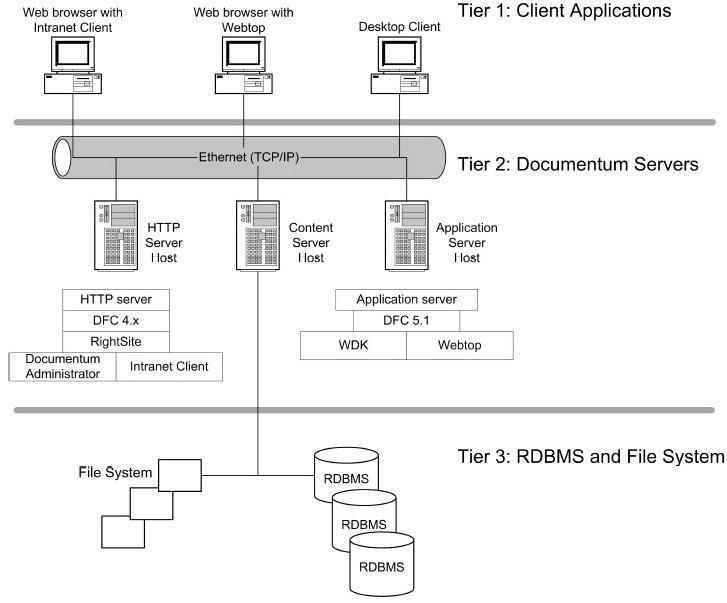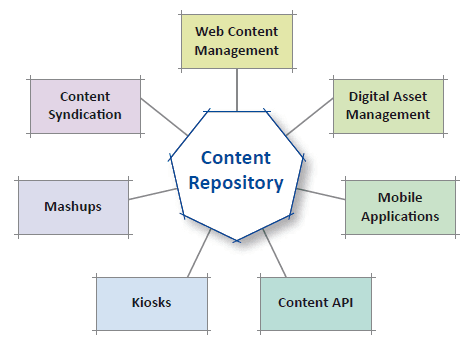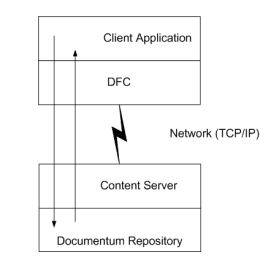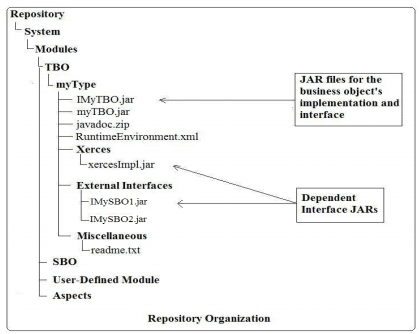- Home
- Blog
- Documentum
- Documentum Tutorial - What is Documentum?

Today, in any organization, content management has become a tedious task as a lot of content is getting produced daily. Whether it is managing some content or making its lifecycle a fruitful pitch for the company, IT professionals have to engage a lot of their time in doing it the right way. In order to overcome the challenges faced with traditional content management techniques, Documentum has been introduced over time.
The organizational content can emerge from different sources such as CRMs (Customer Relationship Management) or ERPs (Enterprise resource planning). Hence, we can simply term Documentum as a panacea to manage every kind of digital content used in the organization. Using Documentum also helps in producing a more efficient decision-making process.
Documentum works as an Enterprise Content Management (ECM) program, which is used to store valuable content from all over the enterprise in a safe and secure place called a repository. Along with the storage units, it also provides ease of use for controlling and organizing files.
You can easily edit, recover, utilize, or retrieve any important information from anywhere and anytime you desire. Furthermore, it also helps in making your document secure from external and internal risk factors. Here, in this blog, we are going to have a brief look at the features, architecture, advantages, and disadvantages of this ECM platform termed Documentum.
Documentum Tutorial for Beginners
| In this Documentum Tutorial, we will learn the following topics |
What is Documentum?
The Documentum system was developed by John Newton and Howard Shao in 1990, in order to solve the unorganized content problem using relational database technologies. Originally, this system was developed for a company ‘Boeing’ (an aerospace Company) which has a large amount of data in the form of paper documents, information, and training manual.
Its main function was to help the company in storing, maintaining, and organizing thousands of pages of information into a common repository.
The Documentum software also helps in converting paper-based documents into application-ready files allowing a user to save a lot of time, cost, and effort. Enterprise’s ECM system is used to manage the content from other applications from across the organization such as ERPs, CRM systems, and portals.
Furthermore, Documentum provides insight into the organization, where you can easily view, edit, or update any document shared with you through the Documentum system.
For Example, if you are using the Documentum system to edit a file you can “check it out” provided no other member of the company is editing the file. It also blocks others from editing the same file if you are editing it. Moreover, you are also allowed to check out the previously made edits on the document and by whom those edits were made.
For us, the users, it looks like the system stores only one single file.
However, Documentum does have all the previously edited versions of the file. You can also add a small comment mentioning what edits you have made, to differentiate the current versions from the previous ones. The current version of the ECM in the market is known as Documentum D2 16.4 released in 2018.
| If you want to enrich your career and become a professional in Documentum, then visit Mindmajix - a global online training platform: "Documentum Online Training" This course will help you to achieve excellence in this domain. |
Advantages of Documentum
Here are a few advantages of using Documentum instead of any other Content Management Software.
-
Flexible and Supportive Content Capabilities: Documentum’s most advanced ability includes workflow features, lifecycle, and auditing which can be used as per your requirements.
-
The Spreadsheets are controlled and organized: Its system is configured in such a way that it makes the creation and control of highly complex and important documents easier and simpler than any other CMS.
-
Personalized and User-Friendly: As it has the capability to adapt according to the requirement, it makes the interface very much user-friendly.
-
Highly Configurable Documentation: It also has the feature of configuring documents according to the specifications provided.
-
Advanced Usability for Virtual Documents: This system helps in simplifying the use of virtual documents (i.e. a document containing parts of other documents from different authors), throughout the organization.
-
Enhanced User Interface: Widgets and easy-to-use tools help in navigating the software faster.
-
Automated Features: A numbering system or naming a file are made automated which helps in reducing time and effort.
-
Security: EMC enforces a high level of security as these files are kept safe in the software’s controlled repository and also organized.
-
Smarter Display of Content: Documentum provides a smarter way of viewing content. It previews the content in thumbnail form, which helps in a search operation for any document.
-
Search Engine: EMC also has a search engine similar to the web search engine i.e. users can look for the file by looking for a certain keyword or phrase.
-
Workflow: Other than routing documents within the Documentum system, you can also communicate through Inbox. You can look at all the files you want and can approve or reject any file in the system.
-
Event Notification: EMC’s system also provides a real-time update notification which provides you with a notification for all the changes made in the documents and by whom these changes are made.
Documentum Architecture
The architecture of the Documentum consists of three basic stages namely:
- The Client application
- Documentum server
- RDBMS and File Systems

Image source: onemanwrites.com
Client Application
Documentum system architecture generally follows the architecture of a client/server model. This is the layer where the client performs operations such as editing, creating, and looking up the document.
Here in this layer, we can interact with the server layer i.e. the content server in order to get our task done. The client side sends a request to carry out the task such as editing a file on the server or retrieving a file and the server gets the task done.
Documentum server
Documentum Content Server is a new kind of content server that was designed to simplify the task of creating or editing by using any of the Documentum applications. This server handles the read and writes tasks for web-based client applications.
The server uses HTTP or HTTPS protocol for all communications. The logic from the application layer is transferred to the server and then calls are made using server APIs (DFC – Documentum foundation classes) to the particular repositories.
RDBMS and File System
RDBMS (Relational database management system) is a software developed for storing a large amount of data efficiently. The application layer performs various operations on the RDBMS. These operations can be easily accessed programmatically by an individual.
Situated at the bottom layer of architecture, the RDBMS and Operating system combinedly handle every request provided by the content server layer. It then stores valuable information, in the form of tables, in a relational database.
Layers of Documentum
There are four layers of the Documentum Platform. Let's have a look at these layers below:
Services Layer
The Documentum content server is staged at the base of the Documentum platform which helps in managing the repository and implementing the core content capabilities. The content server then helps in availing these capabilities to the user with the help of the interface layer.

Image Source: opensenselabs.com
The Content repository uses a flexible model to store data and the associated metadata. The documents are made of content files having attributes (metadata). These attributes are collected as metadata which describes the content and the relationships between the content and other contents stored in the repository.
These metadata are then used by the user to search and retrieve the content relevant to their uses. The content stored in the particular repositories can be encrypted by the user in order to protect the data from any uncontrolled access.
Interface Layer
The interface layer is used by the web server clients to create a link and communicate with the content server and the content repositories. It is also known as the data link layer. This layer determines how data bundles are packed and transmitted through the network. IEEE 802.2 and X.25 are some of the common link layer protocols on which the layer commonly operates.
The interface layer consists of the Documentum Foundation Classes (DFC) and many standard APIs (application programming interface), which are used to control and access all of the functionality of the Documentum system. These APIs collectively known as the Documentum application programming interface (DAPI), can be accessed even from the host of applications.

Image Source: unodc.org
Client Layer
Client layer as explained before consists of the basic application and software for client usage. These applications are used to access the Documentum repository. It includes end-user interfaces, administrator tools, and integrations with popular authoring tools and enterprise applications such as Documentum desktop or WebTop.

Image Source: undoc.org
The components of the client layer are built on content management services available from the lower layers of Documentum architecture. The components in applications, that are built, can be common for other applications as both the web-based applications and Microsoft Windows-based applications access the same dictionary from the repository.
Application Layer
Documentum’s application layer provides the integration of content servers with enterprise applications. It also offers several products that provide a collaboration of content management systems with the application layer. Here are some products:
- Documentum Content Services for SAP
- Documentum Content Services for Siebel e-Business Application
- Documentum Content Services for Lotus Notes Mail
- Documentum Content Services for Portals
The link is provided with the help of content services which gives the power of all the Documentum functionality to the user.
For example, a customer care executive using SAP or CRM application can check the customer's details, like the bill amount, the customer's segment, usage, and personal details including the phone number, and address, instantly. Other than the executive, their project manager can review the operations and procedures with a single click on the report.
Documentum Foundation Classes
Documentum foundation classes, as mentioned in the interface layer, form a higher-order of API providing all the functionality of Documentum. DFC can be defined as a cluster of Java classes that can make the functionality of the Documentum server available to you by implementing a set of attributes.
The DFC can be used in the following ways:
- Accessing the functionality of Documentum.
- Customize the products of Documentum such as WebTop.
- You can execute the operation by writing a method or procedure to the content server as a part of the life cycle.
- Integration of Documentum application with third-party applications.
DFC is based on Java, and it can easily integrate with the client programs that function on Java. In order, to run DFC API you must have a Java virtual machine (JVM) program on your system. The DFC can either be a machine that runs the content server or it can be a middle-tier system i.e. application developed with the help of a web development kit (WDK).
Documentum Business Objects
Documentum Business Object Framework (BOF) is an object-oriented framework that can be built into DFC in order to develop a custom application. BOF in DFC has the capabilities of :
- Extending and enhancing the core functionality of Documentum
- Modify or add the types and behaviors of the existing Documentum.
- It also allows the client to add new attributes dynamically.
BOF provides the developer with the option of installing the BOF modules dynamically and directly on the storage. It allows you to use the application without adding any custom JAR files manually into each application. The dynamic usability of the BOF module also provides you with the ability to update any module directly into the repository without shutting down the application.
The reusability factor of the BOF module gives you access to its modules in any type of DFC-based Documentum application. i.e. you don’t have to create a new module for every application. This feature reduces time and effort and helps the user in building the solution faster.

Image source: emc.com
When you create a new module in the repository system, it creates a folder named dmc_module to denote the modules. The implementation of JAR files is then linked to the particular module in the module folder.
Life Cycles of Documentum
A lifecycle in Documentum states the different stages a document goes through during the ‘lifetime’ of that particular document. The lifecycle of Documentum gives an idea of how the changes are made in any document as it progresses through its lifetime. A lifecycle in Documentum also provides you with a notification indicating when the document gets approved by calling the custom codes and performing specific operations.
It can also automate the operations on a document for example if you want to reflect the approval_date of a particular document, a lifecycle state extension can easily automate the operation.
Lifecycles are created and maintained for usage in any document with the help of the Documentum developer studio. Lifecycles are stored in dm_policy as objects in the docbase. However, only one lifecycle can be attached to a particular document. The r_policy_id attribute and the r_current_state attribute are maintained to store the document’s lifecycle and its current state respectively.
What is meant by Web Services?
The DFC and BOF provide developers with the binding of custom-made business logic that is referred to as the Web Services of Documentum. These custom logic are responsible and are used to call the functions on another document across the internet or in any organization i.e. intranet.
For example, SAP in any organization’s system can communicate with the help of Documentum web services. This functionality of a content management system provides you with a vast variety of knowledge in the form of data and information. This feature also provides you with a broader understanding of the organization such as the productivity or growth of any enterprise.
The main goal of web services is to provide a one-stop shop for enterprises by combining a bunch of systems into one easy-to-use service and making the system mono-lingual i.e. one language SOAP (simple object access protocol). This way it allows us to understand multiple systems and their functionalities using only one interface.
In order to develop these web services over the Documentum API, developers have to work with their respective toolkits and applications. These web services are then implemented over the web servers providing their functionalities to desktop applications or any web applications.
Documentum Web-Based Applications
There are several Web-based applications that provide you with access to several different repositories. Some of these Web-Based applications are :
- Documentum WebTop
- Documentum Administrator (DA)
- Documentum xCP
- Documentum D2
- My Documentum
Documentum Microsoft Windows-Based Applications
The Documentum Microsoft Windows-based applications work only in the offline mode on the system. It also provides you access to multiple repositories.
Some of the popular Documentum Microsoft Windows-based applications are mentioned below:
- Documentum Desktop: it also provides third-party integration to various Microsoft products such as
- windows explorer
- Microsoft Office
- Microsoft Outlook
- Authoring Integration Services (AIS): this is a Documentum system that works on both Windows and Macintosh systems.
Important Products of Documentum
Here are some of the important products of the Documentum system:
- Captiva IEC
- Captiva OEM
- Xpression Enterprise Edition
- Xpression Documentum
- Documentum Platform
- Documentum D2
- ApplicationXtender
- Documentum xCP
- Energy & Engineering Solutions
Documentum WebTop
EMC Documentum WebTop or web desktop is a Web-Based Documentum or client application. WebTop consists of web services, web applications, client-server applications, and many more. Web desktop is similar to the environment provided by the Mac OS, Microsoft, or Linux/UNIX-based systems.
However, in Web Desktop the web applications, files, configurations, and operations, all the functionalities are performed over the network. This provides you access to the functionalities of Documentum remotely i.e. you can access, edit, delete, or view the files anytime and from anywhere. WebTop provides an improved interface with more flexibility.
In any large or medium enterprise, the CMS systems have an excessive amount of workload such as publishing, reviewing, or sharing a large amount of information. Web Desktops help in eliminating this workload by providing numerous settings and specific roles to the group of users based on their workgroups, memberships, and location within the enterprise. With the help of WebTop, you can exclude unnecessary features and focus on more important and particular tasks resulting in increased productivity and faster processing speed.
It also provides you to customize and modify the system according to your requirements eliminating the dependency on IT departments to perform manual coding changes. The WebTops give you access to numerous amount of widgets making navigation through the system much easier.
Documentum Web Publisher
Documentum Web Publisher is a web-based application that also provides simplification of navigation through the system. Web publisher has the capability to automate the creation and publication of documents. It uses the Content Server of Documentum to store and process content into repositories and EMC’s Site Caching Services (SCS) of Documentum in order to publish the content to the web.
The Documentum Web Publisher provides you with the power of creating, designing, and managing interactive portals and websites over the web. Any Non- Technical user can also avail of the benefits of web publishers as it provides easy-to-use tools and widgets that help a user create or edit the content as per their requirements.
It also helps you in understanding and accesses websites which are containing multiple languages by providing advanced functionalities such as navigation, lifecycles, workflows, and site structure.
Documentum Digital Asset Management (DAM)
EMC Documentum Digital Asset Manager (DAM) is a powerful software that provides the administration and intellectual abilities of a client for a content management system. This management system offers full leverage over the client's digital assets by enabling the usage of complete sets of content management systems provided by the Documentum systems.
Digital Asset Management (DAM) also known as Media Assets Management (MAM), Rich Assets Management (RAM) System. DAMA system can be implemented via hosting software using product suits or can be installed via deployment.
Some of the key features and benefits of DAM are mentioned below:
-
File Transformations: Transforms the digital media into multiple formats automatically making the content ready to use over any platform.
-
Thumbnail Display: Provides the view of the files from any folder or search results in a thumbnail and a magnified preview.
-
Active Preview: It can read the document containing multi-page with a web-styled preview or the document preview.
-
Collections: A collection of content can be created and managed with the help of this tool making the content ready to transform, share or download in any specific format.
-
Rendition/Relation Browsing: It can also look at and collect all types of versions of a document be it a low-resolution version file or a web-ready version of the file.
| Related Article: Documentum Interview Questions and Answers for Experienced |
Features of Documentum
Here are some of the key features of Documentum mentioned that make this software different from other content management systems:
-
Regulatory compliance: Regulatory compliances are the guidelines that any organization has to follow. These rules are followed by the Documentum systems as it manages the content in compliance with great building practices.
-
Secure, centralized repository: be it the approval of the content, reuse of content, or reviewing, Documentum performs the operations by providing a secure and centralized repository.
-
Windows-based, web access: Windows-based Documentum provides software to work over the documents in offline mode. Also providing a web-based system that provides content management over the web or the internet.
-
Controlled life-cycle: Implement a lifecycle to every document in order to perform the operations on the content such as approval, reuse, and review.
-
Pure web-top extension: Provides advanced tools and user interface (UI) availing the features of extended search power and interactive widgets to navigate through the system.
-
Collaboration and retention support: It has provided collaborative content while also authoring the content along with retention control support.
-
Enhanced auditing: Legal requirements and satisfactory system requirements are fulfilled to make sure the chain of command.
-
Compliance control: impose a proper approval system with eSignatures to provide a compliance control system.
Benefits of Documentum
-
Role-based security system
-
Easy-to-use software with providing flexibility and faster navigation.
-
Act as a platform and have an Ecosystem of complementary products like Imaging, Publishing, and File Sync & share, etc.
-
Reusability of the content
-
Meet regulatory standards through features like an Audit trail
-
Organizations can save a lot of time, effort, and cost.
-
A highly configured search engine that enables the user to access the specific document from the system.
-
Method to build/configure business rules around content like workflows and lifecycles.
-
Provides both web-based as well as Windows-based system
-
Companies can become more productive
-
Provides better decision-making power by analyzing and producing high-quality content
Conclusion
Therefore, we have seen how Documentum can help in enhancing the growth of any enterprise. It ensures you with an effective content strategy that can match up with your document management requirements. It helps the organization in saving a lot of time, effort, and cost.
EMC’s Documentum system can be configured through multiple channels i.e. by email, printer, mobile, desktop, and many more, making it remotely accessible. With Documentum, the decision-making process in an enterprise can be more effective thus increasing the productivity of the company. Lastly, the Documentum system’s security protocols ensure that the documents are accessed and utilized by the right user while also following regulatory compliances.
Explore Documentum Sample Resumes! Download & Edit, Get Noticed by Top Employers!
 On-Job Support Service
On-Job Support Service
Online Work Support for your on-job roles.

Our work-support plans provide precise options as per your project tasks. Whether you are a newbie or an experienced professional seeking assistance in completing project tasks, we are here with the following plans to meet your custom needs:
- Pay Per Hour
- Pay Per Week
- Monthly
| Name | Dates | |
|---|---|---|
| Documentum Training | Jan 17 to Feb 01 | View Details |
| Documentum Training | Jan 20 to Feb 04 | View Details |
| Documentum Training | Jan 24 to Feb 08 | View Details |
| Documentum Training | Jan 27 to Feb 11 | View Details |

Ravindra Savaram is a Technical Lead at Mindmajix.com. His passion lies in writing articles on the most popular IT platforms including Machine learning, DevOps, Data Science, Artificial Intelligence, RPA, Deep Learning, and so on. You can stay up to date on all these technologies by following him on LinkedIn and Twitter.











